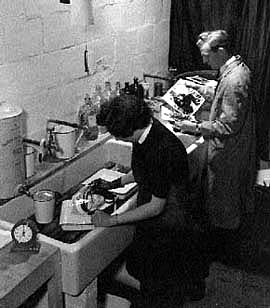Jenny Pike
Breaking New Ground
Breaking New Ground
By Barbara Fosdick

Jenny Pike (left) at work in the darkroom. She was among the first people to see photos from the D-Day invasions, and processing the pictures marked a memorable moment in her career. Photo courtesy of Jenny Pike.
Jenny Pike was one of a groundbreaking wave of female recruits to the Forces during World War II. She was among the first group of young women to be trained as photographers and photo technicians, and helped to process the first pictures of the invasion to liberate north-west Europe – known as D-Day.
Jenny Whitehead Pike was born in Winnipeg in 1922, the youngest of four children. As early as age 11, Jenny was sure she would become a photographer – she often used to help out in her brother’s photo lab.
Later, this experience stood the young shutterbug in good stead when she was hired to work in the photography department of Eaton’s department store.
In 1943, with the Second World War underway, Jenny’s father helped her write a letter to the Secretary of the Naval Board offering her services as a photographer. His support was unusual in an era when many parents disapproved of their daughters joining the Forces. There were no vacancies at the time, but Jenny was encouraged to join the Naval Service as a Probationary Wren.
The Women’s Royal Canadian Naval Service (WRCNS) seemed like a good life and Jenny registered in Feb. 1943. She trained at HMCS CONESTOGA in Galt, Ontario. As Jenny said, it was her first time in a Home for Wayward Girls, which is what the buildings at CONESTOGA were used for before the Wrens took up residence.
In August Jenny was posted to Ottawa HQ for photo training, one of only seven young women in the first class. From there she went on to Halifax in October 1943, and in Feb. 1944, sailed in the third draft to London, England. She had been in London just four months when the D-Day invasions began.
Jenny’s proudest memory of the war was her recollection of developing the first photographs from the D-Day landings. They were the first pictures of the Allied onslaught to be released, and were picked up by the newspaper wire services. Jenny, then 22, was the only woman working in the darkroom at the time.
She returned home from England in April 1945, narrowly missing the Victory in Europe (VE Day) celebrations, to her lasting regret.
In 1949 Jenny married Chief Petty Officer 2nd Class Donovan Pike, a boy she had grown up with and met again when they were both discharged from the Navy. Donovan loved Navy life and with Jenny’s encouragement, re-enlisted. The couple moved to Victoria, a city they both loved. They had two children, a son, Jim and daughter, Susan. Donovan Pike died in 1977.
In 1969, Jenny became a darkroom technician for the Victoria City Police, finally retiring in 1983. Despite problems with her sight, Jenny continued to be an avid photographer and camera club enthusiast, always looking for the perfect shot.
She also maintained her interest in Service organizations, joining the Royal Canadian Legion in Winnipeg in 1946, and later transferring to Ex-Service Women’s Branch 182 in Victoria, of which she was President from 1982-83. She was also active in the ex-WRCNS Association of Victoria.
Jenny was so proud to have served her country,” recalled Barbara Fosdick, former President of Ex-Service Women’s Branch 182.
“I think that my favourite memory of her is from the recent Remembrance Day Parade, when all of the women were told they must march at the back of the parade. Jenny in her wrath was mighty to see,” Barbara Fosdick remembers.
“With fists clenched, she yelled, ‘We are women veterans, we will NOT march at the back, we’re going to join the men where we belong.’ And we did.”
Articles
Hours
7 Days a Week: 10:00 am – 3:30 pm
Monday to Friday: 10:00 am – 3:30 pm
Hours
Monday to Friday: 8:00 am – 4:00 pm
To confirm if we are open, please call (250) 363-5655 or (250) 363-4312
Naval & Military Museum
Info@NavalAndMilitaryMuseum.org
CFB ESQUIMALT NAVAL & MILITARY MUSEUM
PO Box 17000 Stn Forces
Victoria, BC V9A 7N2